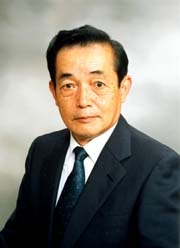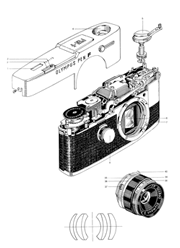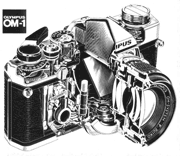
YOSHIHISA MAITANI DIES 30th JULY 2009
A SAD DAY FOR OLYMPUS LOVERS EVERYWHERE

YOSHIHISA MAITANI DIES 30th JULY 2009
A SAD DAY FOR OLYMPUS LOVERS EVERYWHERE |

Yoshihisa Maitani - one of the last company portraits |
It is with great sadness I have to report on the death of Yoshihisa Maitani on 30th July 2009. Mr Maitani died in a Tokyo hospital of respiratory failure. He was 76. His death was originally reported to the world by the Asia arm of CNet here . Mr Maitani was born in 1933 in the rural Kagawa Prefecture of Shikoku Island, the son of a rice wine merchant. He held a life-time fascination for cameras and a love of photography. As a young boy he designed, made and patented cameras. After university he joined Olympus in 1956 and worked initially as a designer. He went on to become chief designer, followed by managing director until he retired from the company in 1996. He remained as a company adviser and attended the corporate headquarters in Tokyo on a weekly basis well into 2006. He also gave many lectures in Tokyo about the company and their camera products and was greatly loved and respected by the photographic fraternity in Japan and the world over. Without doubt one of the finest minds in camera design and development Yoshihisa Maitani was actively head-hunted whilst at University by Eiichi Sakuria, a senior design engineer and Olympus company boss, who signed him up to join the Olympus Optical Company rather than his chosen career, that of automobile engine design. After obtaining his degree, Mr. Maitani joined Olympus in 1956 and spent his first two years familiarising himself with the various parts of the company before being assigned to the Development group. Early in 1958 he was given the task of designing a 'cheap' camera to fill a gap in the company's product range. His only target criteria was its selling price, 6000 Yen. After many attempts and much self criticism he recalled the lesson of one of his university lecturers and stripped the problem right back to basics. Whilst prepared to economise on virtually everything else, he stubbornly refused to fit a cheap lens to his new camera. Instead he insisted on a Tessar type triplet lens thus setting his colleague, Yoshisada Hayamizu, a formidable challenge, to produce such a well specified fully moving lens at such a low price. Many of the Pen's design features, including the choice of format, were the result of Mr. Maitani's cost paring to hit the company's price target. Some five different 'mock-up' models were made, much to the astonishment of his design colleagues. The Pen Original went into production in October 1959 and was originally outsourced to another manufacurer until Olympus realised they had a winner and took over direct production in June 1960. This gem of design was set to both create and then dominate the half frame market for the next two and a half decades. Mr. Maitani now leads the design team to develop the viewfinder Pen through many iterations and in the next five years huge technological advances are made including automatic exposure (Pen EE) and the world's first fully automatic motor-drive/rewind half frame camera, the Pen EM. (Mr. Maitani did not design the Pen EM and had nothing to do with it!) About 8 million Pen cameras were made.
|

Pen F - Exploded diagram |
Because both he and the company recognised the need for an advanced half-frame camera, his next challenge is to design a Single Lens Reflex System camera based on the enormous success of the viewfinder Pen. Thus challenged he produces in 1963 another world first - the Olympus Pen F System - a half-frame interchangeable lens reflex camera, an array of top quality lenses, system accessories and with the Pen FT in 1966 the first TTL metering. With a new rotary shutter that synchronises at all shutter speeds this is a remarkable achievement, and he is still a young man. In spite of its huge popularity elsewhere, the Pen series is considered unsuccessful in the important USA market because the film processors are reluctant to tool up for half-frame. The SLR Pen is not a commercial success. During the years Mr Maitani was developing the Pen cameras his mind was filled with the ambition to design a full frame 35mm SLR camera. In 1966 he started the process that would lead to the world shaking M(OM) series. Into an age of large, clumpy, noisy full frame SLR's he introduces a tiny full frame 35mm SLR system camera that leads the field and in 1972 the world is introduced to the Olympus M1. It could have been smaller but his design reflects a photographers insight, and a truly remarkable system camera is born that sets the standard for years to come. How does the designer follow that? With remarkable vision he concentrates on the next generation of cameras, sculpturing in clay a small, compact and pocketable camera that is to be copied by all others. Of extremely high quality, offering manual and semi-automatic features with no need for case or lens cover, he produces the XA range of 'capsule cameras.' His design genius can be seen in many of the later Olympus offerings, particularly the Mju range that goes from strength to strength. Over the last 50 years the 'Maitani' influence can be seen on many Olympus products. In fact Olympus has looked backwards for inspiration when facing some of the challenges of the digital era. For example the E-300/E-330 shared the side swing mirror with the 1963 Pen F half-frame SLR. And its latest innovation, the E-P1 (digital Pen) draws heavily from the same camera, the Pen F. |

OM1 - Exploded diagram |
But it is not just his design genius that echoes through Olympus. He was known for his clear thought and tenacity when problem solving. From the shutter strings on the OM series to the moulding of the XA capsule camera sliding door, he refused to be beaten though all around him gave up. From the simple Tessar triplet lens on the first Pen camera to the incredibly complex retro-focus lens fitted to the XA, he also inspired others to share in his dreams. The Maitani legacy lives on within today's camera division. From the Pen designed down to a price, to the OM system that boasted over 260 components, the designer remains what he always has been - a photographer. He could not quite fulfill his dream by mechanical sophistication, though he tried. But his ultimate vision of making a photograph as easy as recalling a memory is almost here now with the digital age. Thank you, Yoshihisa Maitani - your contribution has been enormous. |
|
HOME |
INTRO |
BOOKS |
OLYMPUS CIRCLE |
QUEST |
TOC MEMBERS |
GALLERIES
|
| Posted 31st July 2009 | Copyright © 2009 John Foster |